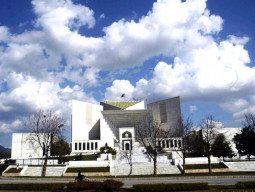
BAHAWALPUR:
Elderly residents of Phattay Wali Gali, one of the oldest streets of Bahawalpur, swear there is a secret passage built under Kaala Dhari Mandir which goes to Delhi. Though no one has ever found the fabled passage its legend lives in the collective memory of people living on the ancient street.
The temple, meanwhile, lies in shambles.
According to locals, the 300-year-old temple, originally called Shiri Nani Dev Kaala Dhari Jee Maharaaj Mandir, is the oldest and one of the most beautiful temples that still remain in the area. The detail put into construction, woodwork, tile art and carved frescos provides a fascinating subject for artists and students of history.
The floor of Kaala Dhari Mandir has intricately painted marble tiles and the pillars holding up the ceiling have been carved and painted by master craftsmen of their time. The paintings on the floor and pillars tell stories of legends and myths of yore.
During the scorching summers, the black and white tiled floor of temple’s compound feels cool to touch. Locals say they do not understand the architectural wonder behind the secret of the cool compound floor but say it is always brings a sigh of relief from the heat.
The main gate has intricate carvings of gods and goddesses worshipped by, what locals call, Vishnu’s tribe. The gate is kept at the Bahawalpur Museum. In fact, several paintings and artefacts at the temple have been taken to Lahore Museum.
The building, exposed to torrential rains and harsh weather conditions, has a battered and weathered look to it. Years of neglect have allowed certain portions of it to crumble.
“A few months back, the floor of a room in the temple collapsed…after a tunnel built under the room caved in,” Muhammad Aslam, a resident of Phattay Wali Gali says. “It’s no use complaining about it to anyone, so we got together and repaired the floor ourselves.”
The Bahawalpur Municipal Corporation runs a primary school on the temple’s premises. Evacuee Trust Property Board has handed over the building’s first floor to tenants.
Bahawalpur Archaeology Department Sub-Engineer Muhammad Iqbal says that Kala Dhari Mandir is not on their list of buildings to be restored. “If someone writes an application to the Archaeology Department director general in Lahore, then maybe, he would appoint a person to conduct a survey of the buildings and decide whether or not it should be restored at all.”
Archaeology Department Deputy Director Afzal Khan says the upkeep of the mandir is up to Evacuee Trust Property Board. “Temples at Katas Raj have been restored on the recommendation of the ETPB. If they ask us to restore the temple, we will start on the project.”
ETPB Deputy Director Faraz Abbas says he knows of the mandir. “However, I cannot comment on why it has not yet been restored.”
Yet for the people in the street, the smell of burning Sangwan wood (teak) – the material the temple’s doors and gate were built of – are etched in their memory. “It is a beautiful smell which pervades the entire locality,” recalls Muhammad Anwar, another resident of the street.
He says a few years ago, the administration took away all the wood in the temple – doors, gate, furnishings. The main gate is kept at the Bahawalpur Museum but no one knows where the doors have gone, he says.
Naseem Akhtar, a resident of the area, says the temple is a relic of the past and a symbol of interfaith harmony for people who live in the area. “The building has historic value. The building is still beautiful to behold. The hand-painted and carved frescos need attention.”
Published in The Express Tribune, September 6th, 2015.
















































COMMENTS
Comments are moderated and generally will be posted if they are on-topic and not abusive.
For more information, please see our Comments FAQ